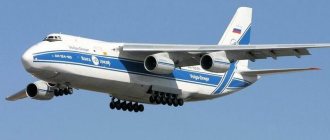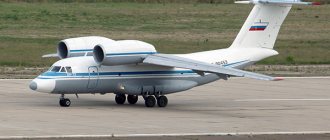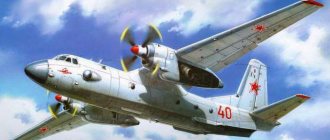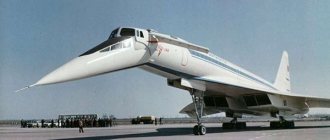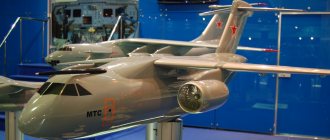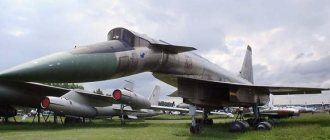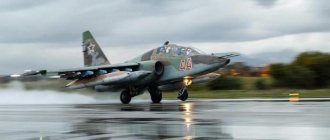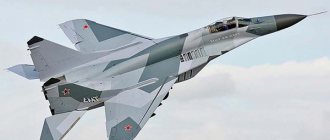The history of a unique Soviet transport aircraft created at the EMZ V.M. Myasishcheva
By the resolution of the Central Committee of the CPSU and the Council of Ministers of February 17, 1976, Soviet industry was tasked with the creation of a universal rocket and space transport system (URKTS) “Rassvet”, which later received the name “Energy”. It was supposed to launch various heavy vehicles into orbit, incl. and VKS "Buran". NPO Energia was responsible for the creation of the entire system, and the development of the Soviet space shuttle was entrusted to NPO Molniya, which, in addition to the machine-building plant of the same name, also included the Myasishchevsky Electromagnetic Plant.
With the advent of the Energia-Buran rocket and space transport system, the need arose to transport individual large blocks to Baikonur. Hundreds of large factories took part in the creation of the Energia-Buran system, among which the production of the components of the launch vehicle and the airframe of the orbital aircraft was distributed. This created a serious problem of determining the assembly sites and delivery of these parts to the launch site, to the cosmodrome. Initially, it was proposed to concentrate the main technological assembly processes at Baikonur, but this was considered inappropriate, since it required the organization of powerful production workshops there and the involvement of a large number of qualified specialists. It was decided to carry out only final assembly and pre-launch testing at the cosmodrome, and carry out the main volume of assembly work at the main plants.
The assembly of the Buran airframe was entrusted to the Tushinsky Machine-Building Plant. To select the means of its delivery from Moscow to Baikonur, the possibilities of land and air transportation were studied. A meeting was held at the Ministry of General Engineering on this issue. Calculations have shown that the material costs of land transportation, which requires the construction of expensive long-distance highways, are unacceptably high.
Options for using glider air delivery vehicles turned out to be preferable. The manufacturers of the launch vehicle came to the same decision. Two options for air transportation were considered: helicopter and airplane.
For helicopter delivery, it was proposed to use the newly introduced Mi-26 helicopter with a lifting capacity of 26 tons. According to this project, 2 or 3 helicopters were connected by cables to large-sized cargo of large mass (airframe, rocket compartments), and with such a “bundle” it was proposed to follow the route, selecting the optimal altitude and flight speed. The basis for this option was the example of the use of helicopters for “crane” operations, but there was no experience in “team” flights.
At LII, experimental flights were carried out with a prototype cargo having the configuration of a rocket tank compartment. The tests revealed the complexity and dangers of this type of delivery. During one of the flights, when weak atmospheric turbulence suddenly arose, a “pendulum” swing of the load on the cables began, which caused a disruption in the stability of the helicopters’ flight, as a result of which the crews were forced to drop the load.
The calculation showed that such a situation is likely in future flights, and with more intense atmospheric disturbances it can lead to catastrophic consequences. The economic unprofitability of its use also contributed to the abandonment of this option: the short range of non-stop flight of helicopters with suspended cargo led to the need to create numerous landing sites with refueling stations, frequent along the route.
The An-124 Ruslan aircraft was intended for air delivery of large fragments of the Energia-Buran system. However, this aircraft was still under construction. It was possible to count on it only in the future, and it was necessary to look for other opportunities. An attempt was made to use the An-22 Antey aircraft. We considered two options: placing cargo on top of the fuselage and inside it. However, both methods were not approved. The first one turned out to be unpromising due to the difficulty of ensuring directional stability and controllability of the aircraft in the presence of such a large external object. The second is due to strength and layout problems. In general, the plane did not work out even as a temporary measure.
Subsequently, the An-22 was nevertheless adapted for air transportation of cargo outside the fuselage. This frame captures the moment of transporting the wing console of the An-225 Mriya aircraft from the manufacturing plant in Tashkent to assembly at the Antonov Design Bureau in Kiev. Especially for these purposes, a third keel was installed on the An-22, which improves the directional stability and controllability of the aircraft.
The initiative was taken by General Designer V.M. Myasishchev, who proposed converting the strategic bomber of previous years, the 3M aircraft, into a cargo aircraft. This aircraft had a high aerodynamic quality necessary for long-range flights, which could be sacrificed when it was converted into a cargo transporter.
Two options for its modification were considered. The first option is to place cargo inside the enlarged cargo compartment of the fuselage (similar to the Galaxy aircraft). This required the creation of a new fuselage with an increased diameter (10 m instead of 3 m for the 3M aircraft). In this case, the Buran glider had to be transported with undocked wings (the Buran’s wingspan was ~ 24 m), which involved removing part of the tiled heat-protective coating. At the same time, the bicycle chassis of the 3M aircraft had to be replaced with a three-wheeled one. As a result, the weight of the aircraft structure increased, which caused its carrying capacity to decrease. But, most importantly, the production time for the cargo version was becoming unacceptable. The second, V.M. Myasishchev, proposed an option with smaller modifications to the bomber, namely with the placement of cargo outside the airframe, on the “back” of the fuselage, which made it possible to transport cargo with minimal changes in their configuration. The idea of placing transported cargo outside the aerodynamic contours of the aircraft was, in principle, not new. This solution is widely used in combat and transport aviation of all countries. The novelty lay in the unusual relationships between the dimensions of the cargo and the carrier aircraft (the diameter of the rocket tank compartments is 8 m, the diameter of the aircraft fuselage is 3 m).
His thoughts were simple and clear. The aerodynamic quality of his aircraft VM-T Atlant (3M-T) is unprecedented for this class of aircraft - 18. And if you place a load weighing 40 tons and a diameter of 8 meters on it, the quality will drop to 12 - normal for a cargo aircraft. In addition, the support struts of the bicycle chassis are spaced apart in the aircraft over a span of more than 50 m.
It is known that when the payload is placed externally, the aerodynamic and mass-inertial characteristics of any aircraft change significantly; to assess the changing flight performance data due to this, serious studies of the dynamics of motion and ensuring operational safety are carried out. The tasks that needed to be solved when implementing V.M.’s proposal. Myasishchev, were much more complex than traditional ones. The OKB joked about this topic:
It was necessary to change the geometry of the 3M aircraft in such a way that it became possible to place on its airframe all the cargo of the new system intended for air delivery. At the same time, the installation of each specific load on the aircraft changed its aerodynamic characteristics and elastic-mass configuration so significantly that an aircraft of a new aerodynamic and dynamic configuration was essentially formed. In this regard, there was a need to repeat all the studies on aerodynamics and strength previously carried out for the 3M aircraft during its creation.
V.M. Myasishchev’s proposal was met with skepticism by many aviation experts. There were many reasons for doubt. How was it possible to place loads on the finished glider that exceeded some of its dimensions? How to overcome a sharp increase in drag without deteriorating the basic flight characteristics of the aircraft? Will it be possible to control the aircraft and ensure lateral stability in flight in the presence of destabilizing effects from overhead cargo? How can we eliminate the danger of empennage buffeting, which manifested itself during the flight of the Boeing 747 with the Space Shuttle? For the 3M aircraft, this phenomenon could become more dangerous. And finally, is the structure of an aircraft that has been used in long-range aviation for more than 25 years capable of withstanding loading under new operating conditions if it already has numerous fatigue damages?
The main design decision made, as mentioned above, was the sacrifice of the high aerodynamic quality of the ultra-long-range aircraft 18.5 to compensate for the increase in drag from the loads on the “back”. This was acceptable, since the length of cargo transportation was set to be less than the available flight range of the 3M aircraft. The flight speed, which had to be reduced due to the installation of weights, beneficially reduced loads and increased safety from flutter. A positive factor in favor of transforming the 3M aircraft into a transporter with cargo on the “back” was its bicycle-type chassis with auxiliary support struts at the ends of the wings. This scheme ensured stability of movement on the ground in crosswinds and protected the aircraft from tipping over by forces acting on the cargo placed above the fuselage. The buffeting phenomenon was supposed to be mitigated as much as possible by replacing the single-fin vertical tail with a double-fin one.
The design of the 3M aircraft airframe was carefully studied throughout its 25 years of operation. During this time, three aircraft underwent repeated static strength tests at SibNIIA; based on their results, the strength of aircraft in service was monitored. They were also supposed to help find solutions to replace or strengthen the most critical structures of a cargo aircraft, taking into account the new conditions of their loading. To ensure stable and controlled flight, it was supposed to make changes to the control system. Of course, detailed studies of all variants of the dynamic design of the aircraft (with different loads) were necessary to determine the loading of the elastic structure and ensure safety from flutter and buffeting.
The transformation of the 3M aircraft into the VM-T Atlant cargo transporter (factory code 3-35) required changes to its layout, which made it possible to place all the specified cargo in the configuration:
- OGT - glider of the orbital ship "Buran" (without keel);
- 1GT - hydrogen tank of the central stage of the Energia launch vehicle, with nose and tail fairings;
- 2GT - oxygen tank, instrument and engine compartments, the head part of the central stage of the Energia rocket, combined into one unit, with a nose cone disassembled into sections, and the head part used as a tail fairing;
- 3GT - head and tail fairings of the 1GT cargo, docked into one unit, with the nose fairing of the 2GT cargo placed inside, disassembled into sections.
The technical solutions being developed had one goal - to deliver the cargo to its place and not cause harm to the transportation object. The largest of them (in terms of dimensions) was the 1GT hydrogen tank, which was to be equipped with removable transport frames with attachment points to the aircraft, a front fairing and a rear stack, giving the object an acceptable aerodynamic shape. Missile tanks are a very delicate load. These are thin-walled non-rigid shells, designed for longitudinal rather than transverse loads, requiring the maintenance of absolute cleanliness in the internal cavities.
During transportation, the hydrogen tank was inflated with nitrogen and sealed. The pressure was continuously monitored in flight by a measurement system, the readings of which were placed in the pilot's cabin in the form of a separate console. In the event of depressurization, not only landing, but also the descent of the aircraft became impossible - the escaping gas could not counteract the rapidly increasing external pressure. And the tank, having lost its shape, would inevitably lead to the loss of not only the cargo, but also the VM-T Atlant (3M-T) aircraft.
Another feature of this cargo: the fairing and drip cap are hollow and unsealed inside. However, their uncontrolled leakage can cause the same effect as a gas leak in the tank. To prevent this from happening, we pressurized the fairing and defroster with a counter flow of air through special air intakes. For balancing, the cargo was equipped with sandbags. The permissible spread in the position of the center of mass is no more than 25 cm, and this is with a mass of 32 tons and a length of about 45 meters! To speed up the pace of development and construction of the carrier aircraft, three tankers were selected and sent for endurance testing.
The 3GT cargo was used as a container for returning from the cosmodrome to fairing manufacturing plants for reuse, and also, if necessary, for transporting the crew cabin module.
As a result, the VM-T Atlant was to be operated in five different configurations: four - with loads 0GT, 1GT, 2GT, 3GT; one - without cargo (the so-called “autonomous” option).
Placing cargo on the “back” of the aircraft became possible after lengthening the fuselage by 4.7 m, which was done by replacing the tail section, slightly raised due to an “oblique” insert to avoid impact with the ground during landing and takeoff at high angles of attack. Research into stability and controllability led to the need to change the size and shape of all tail surfaces. Due to the decrease in flight speed, the stabilizer of the swept horizontal tail was replaced with a straight, larger area, installed with a large transverse V. Instead of a single-fin vertical tail, a significantly increased (up to 26% of the wing area) double-fin was installed, made in the form of two washers, obliquely mounted on ends, stabilizer, which helped reduce loads on the fuselage.
Layout option 0GT
Family "48"s
In the photo: 1. Project of the “product 46” rocket plane with gliding descent.
2. Installation diagram of the manned reusable aerospace aircraft “Izdeliye 48-IV” on the launch vehicle “Izdeliye 47” (OKB-23’s own development). The first stage of development involved the creation of an experimental device with a crew of one person to test gliding descent, including landing, on-board equipment and study human activity in space flight conditions. Four variants of the device were considered:
• “48-I” winged design with low angles of attack upon entry and braking by hypersonic flaps;
• “48-II” winged design with high angles of attack at entry and gliding landing;
• “48-III” wingless “reverse cone” design with a rotary escapement;
• “48-IV” cone with hypersonic wings and brake flaps (option with parachute landing).
According to the stories of Doctor of Technical Sciences Evgeniy Kulagi (veteran of OKB-23, later the chief designer of the theme of the State Space Research and Production Center (GKNPTs) named after M.V. Khrunichev), “a manned reusable aerospace aircraft (VKS) ["product 48 -IV." - Ed.] was a small swept-shaped aircraft with a flat bottom." In plan, the device had the shape of an almost regular equilateral triangle. In fact, it was a low aspect ratio flying wing.
According to Kulaga’s recollections, the rocket plane “48” was created in collaboration with OKB-1 (S.P. Korolev) and NII-1 (M.V. Keldysh). Korolev was very respectful of Myasishchev. They met back in 1939 in the “Tupolev Sharashka” - TsKB-29 of the NKVD, where both ended up as “enemies of the people.” Since then, Myasishchev and Korolev have maintained personal contacts.
Work on topic “48” reached the stage of thermal testing of design samples with thermal protection in the jet of a jet engine. However, the campaign against military aircraft production did its job: in October 1960, OKB-23 was transferred as branch No. 1 to OKB-52, led by Vladimir Chelomey, which dealt with missile issues. Myasishchev was appointed to the post of head of TsAGI.
Layout option 1GT
Technical characteristics (M-50A) [ [ edit ]h2>
Rear view of Myasishchev M-50
Data from
[8[8]p>
General characteristics
- Crew:
2 - Length:
57.48 m (188 ft 7 in) - Wingspan:
25.10 m (82 ft 4 in) - Height:
8.25 m (27 ft 1 in) - Wing area:
290.6 m2 (3,128 sq ft) - Empty weight:
85,000 kg (187,393 lb) - Gross weight:
175,000 kg (385,809 lb) - Maximum takeoff weight:
200,000 kg (440,925 lb) - Powerplant:
2 × Dobrynin VD-7F turbojet engines with afterburning, 137.29 kN (30,865 lbf) thrust each wet - Powerplant:
2 Dobrynin VD-7 turbojet engines with a thrust of 110 kN each
Performance
- Top speed:
1,950 km/h (1,210 mph, 1,050 kn) - Cruise speed:
1,500 km/h (930 mph, 810 kn) - Range:
7,400 km (4,600 mi, 4,000 nmi) - Service ceiling:
16,500 m (54,100 ft) - Wing load:
602 kg/m2 (123 lb/sq ft) - Pull/weight:
0,29
Armament
- 30,000 kg (66,000 lb) bombs or missiles carried in internal compartments, including M-59 and M-61 long-range cruise missiles [9[9]li>
2GT layout option
Rescue arrest
The times were not easy for the army when its entire leadership was repressed. To the credit of individual NKVD workers, they tried to save the “brains of the Armed Forces”. Perhaps that is why in 1938, acting ahead of Beria’s bonebreakers, leading aircraft engineers were arrested, forced to sign a confession of sabotage, tried and sent to serve their sentences in prison design bureau No. 23.
Once there, Myasishchev was surprised to see familiar faces: his mentor Petlyakov, who had been arrested earlier, Tupolev, Korolev and a dozen other aviation specialists. They not only worked together, but also lived in the same premises.
However, the NKVD has never been a charitable organization. Vladimir Mikhailovich's liability included a 10-year prison sentence and confiscation of property. The asset is a preserved life, ability to work, and talent, allowing one to be rehabilitated in the future.
The designer was a good family man. What helped him survive the trials was the hope of returning to his family again. As he recalled, it was only thanks to his wife’s letters that he did not break down.
3GT layout option
The wing and the rest of the fuselage (including the cabin) were unchanged in size and shape, as were the nose and main landing gear of the bicycle.
Based on the test results and the identification of the weakest points, they were strengthened or replaced, new wing and fuselage panels were made, and the frame was updated.
The underwing landing gear was redesigned and manufactured to accommodate the increased loads encountered by a loaded aircraft during banked landings and taxiing around the airfield. The supporting structures of the wing and fuselage were strengthened to cope with the loads determined by the new operating conditions. The necessary modifications were made to the aircraft's fuel system. The 15B engines were replaced with more powerful ones - 17D.
For the adopted five aircraft configurations, studies were carried out on aerodynamics, stability and flight controllability. For each cargo option, its most advantageous placement on the fuselage (in length and height) was determined based on the conditions:
- reduction of drag;
- limiting the spread of moment characteristics;
- obtaining the necessary alignments;
- weakening the dynamic impact of the vortex sheet coming off the cargo and gas jets of engines on the tail surface (buffeting).
It was found that the main load-bearing characteristics, with changes made to the layout, were practically preserved for all options. As expected, the maximum lift-to-drag ratio decreased significantly (by 30...35%). The increased aerodynamic moments arising from large loads (1GT and 2GT) were compensated by the aforementioned introduction of a larger direct stabilizer. The destabilizing lateral impact from the loads was completely counteracted by the vertical tail washers. Their excess area when flying without cargo required the introduction of a special automatic device for control that ensures the necessary stability and controllability (ASUU). A study of aerodynamic interference between the aircraft and cargo was also carried out, revealing a pattern of distribution of local air loads on the surface of the fuselage and cargo. Strength studies made it possible to ensure minimal mass costs for changing the airframe design and at the same time solving the problem of aeroelasticity. This was facilitated by the adopted reduction in flight speed, which reduced the design loads. The permissible maneuvering overloads allowed to the crew were limited to the following values:
In order to increase operational safety, large design values of overloads were adopted:
When determining dynamic loads and flutter studies, materials obtained for heavy aircraft at the V.M. Myasishchev Design Bureau in the 50s were used. The dynamic loading of the tail section of the aircraft from buffeting was studied in the wind tunnels of TsAGI and SibNIIA and was monitored during flight tests of the first copy of the aircraft. It has been proven that safety from buffeting is ensured for all VM-T variants. Stresses in the structure of the tail and fuselage during buffeting turned out to be within limits not dangerous for fatigue strength.
The strength of the landing gear (main and underwing) was verified by static and dynamic tests.
One of the main challenges of using 3M airframe assemblies for the VM-T aircraft was updating their design to ensure safe operation. To justify the service life assigned to the VM-T aircraft, together with scientists from TsAGI and SibNIIA, calculations were performed and special tests of the modified design were carried out, taking into account previously performed studies of three 3M aircraft airframes.
The design of the ZM-T was in full swing when General Designer Vladimir Mikhailovich Myasishchev died on October 14, 1978. The chief strength engineer of the company, V.A. Fedotov, was appointed acting head of the EMZ, and the responsibility for completing the creation of the unusual “transporter” fell on his shoulders. In the second half of 1979, two ZMN-2 aircraft allocated by the Air Force (Nos. 1402 and 1502) entered pilot production of the EMZ. Their alteration was carried out in close cooperation with many enterprises of the Ministries of Aviation Industry and General Engineering, in particular, with the plant named after. Khrunichev, Tashkent and Omsk APO. Each “emka” underwent an extensive set of modifications, including the installation of a new tail section and empennage, significantly strengthening the landing gear and airframe (for example, detachable parts of the wing became three-spar), sewing up the bomb bay, and dismantling all weapons.
Finalization of the design was controlled by full-size static tests of the airframe. The strength of the transported goods was ensured by their developers.
Three aircraft were built, designated ZM-T, one was transferred to TsAGI for statistical testing. Of the two flight ones, one was equipped with an in-flight refueling boom.
At the end of 1980, aircraft No. 1402 was transferred for ground testing. Jogging began in March of the following year. During the first of them, the crew of Anatoly Petrovich Kucherenko missed the braking point. There was not enough lane to stop. Therefore, at the end of the runway, the crew turned the plane 180 degrees at a speed of 60 km/h. To everyone's surprise, the cargo remained in place and the plane was not damaged. On April 29, the crew headed by A. Kucherenko took this machine into the air for the first time. The first stage of testing, despite all its uniqueness, was completed in a short time, and already in April 1982, two transport flights took place along the Kuibyshev-Leninsk (Baikonur) route, which delivered cargo 1GT and 2GT to the cosmodrome. In the same month, aircraft No. 1502 made its first flight with a 1GT cargo mock-up.
“But Myasishchev wants it!”
At the end of the war, Myasishchev and his design bureau began work on a project for the RB-17 jet bomber with four RD-10 turbojet engines. However, at the beginning of 1946, the design bureau, whose employees had recently been awarded government awards, was disbanded. The reason given was the “low impact” of the design bureau. Myasishchev’s developments were transferred to the Ilyushin Design Bureau, where the Il-22 jet was built on their basis.
Myasishchev began teaching at the Moscow Aviation Institute, where he was the dean of the aircraft department. He was able to return to work as a designer in the early 1950s, when the country needed a new strategic bomber.
Members of the government liked Myasishchev’s proposals, and on March 24, 1951, his OKB No. 23 was recreated.
Here the designer entered into an absentee dispute with Tupolev. Stalin demanded that Tupolev create an intercontinental bomber with certain characteristics that the creator considered unrealistic. “But Myasishchev wants it!” Stalin answered irritably.
This is how a real competitive struggle began between Myasishchev and Tupolev.
Question answer
Strategic bomber-missile carrier Tu-95. Infographics
Loading cargo on VM-T Atlant
It is interesting that when one of these ships, painted in the colors of Aeroflot and with the inscription ZM-T on board, caught the eye of a vigilant regime official, he categorically demanded that the designation, which testified to the bomber past of the aircraft, be painted over. They didn’t do this, but the number “3” was corrected to the letter “B” and received VM-T, although according to all documents the car continued to fly under the same designation (when the plane began to be shown at various air shows, some printed publications deciphered these three mysterious letters like “Vladimir Myasishchev-transport”). Later the plane received its own name "Atlant".
In 1983, tests began with a mock-up of the VKS mounted on the fuselage, which did not have a keel, and a fairing was installed in the tail section. It weighed less than the Buran, a little more than 45 tons. From March 1 to March 25, 8 flights took place in Zhukovsky, the last of which ended in an accident. Due to an error by the second pilot when extending the landing gear, the front landing gear was not fixed along the longitudinal axis and became uncontrollable, as a result of which the plane was blown off the runway when landing with a crosswind. It was buried in the ground up to the wheel hubs, and then was damaged when pulled out onto the strip by tractors. The model of the VKS was safely removed with heavy cranes from the “back” of the damaged aircraft, and it itself had to be sent for repairs, which dragged on until November.
In the second half of the eighties, work on the URCTS program reached the stage of flight testing, and in the spring of 1987, VM-T aircraft delivered system components to the cosmodrome for their final assembly and launch preparation. Alas, the first launch ended in an accident - a giant rocket and a hundred-ton satellite fell into the ocean. This misfortune significantly strengthened the position of opponents of the program, among whom were not only party functionaries of Gorbachev’s Central Committee, but also prominent rocket designers. For example, the famous cosmonaut, Hero of the Soviet Union, spoke out against the Energia-Buran system in the form in which it then existed, and in the mid-1980s. one of the main designers of space technology K. Feoktistov.
And yet we managed to prepare one more launch. With the help of VM-T, parts of the second URCTS, as well as the “combat” VKS, were delivered to the cosmodrome. "Buran" arrived at Baikonur already with a keel, but without many systems, since the carrying capacity of the "emka" did not allow it to be transported fully assembled. The unmanned launch, which took place on October 15, 1988, ended with the famous triumphal landing, but this success did not in any way affect the future fate of the program. Soon the work was stopped, and the Atlant pair was left out of work. In total, they completed about 150 test and commercial flights. The aircraft was also used as a carrier for an analogue of the Buran spacecraft (BTS-01). BTS-01 was located on an external sling above the fuselage of the carrier aircraft and was supposed to be separated from it in flight, followed by an independent landing. During test tests, the crew of the BTS-01 analogue consisted of cosmonauts Evgeniy Khrunov and Georgy Shonin, the carrier aircraft was piloted by Yuri Kogulov and Pyotr Kyiv. In recent years, VM-T was regularly demonstrated in flight with cargo at aviation festivals, and in August 1992 it was exhibited at Mosaeroshow-92.
For its specific appearance - the “lean” fuselage inherent to a bomber with a bulky container on the back - the VM-T received the name “flying barrel”.
It is worth remembering that VM-T was intended as a temporary solution. The maximum load that he could take on his “back” did not exceed 50 tons. Which introduced many restrictions into the space program. Some of the equipment had to be removed from the Buran, reducing its weight to 45 tons. And in the plans for space flights it was envisaged in the future to transport cargo weighing up to 200 tons to Baikonur. An aircraft with a larger carrying capacity was required. This is exactly the kind of project they were working on at the Antonov Design Bureau. The new An-225 Mriya transport aircraft was supposed to carry 225 tons of cargo on its shoulders. But it so happened that by the time of the first and only flight of Buran into space, Mriya was not ready. The spacecraft made its flight on November 15, 1988. And “Mriya” took off for the first time only a month later - on December 21 of the same year.
It turns out that VM-T, which was intended as a temporary solution, did all the main work of transporting the elements of the rocket and the ship to the cosmodrome. And the Mriya, which passed the tests, carried the Buran around the world, demonstrating its capabilities at air shows in Europe and America. The secrecy surrounding the space program has hidden the true hero of this transport from the public. And even now many believe that it was the Mriya that carried the Buran; they know nothing about the VM-T Atlant.
At EMZ named after. V.M. Myasishchev tried to find a use for unique special aircraft. In the 1990s. Among various projects, the option of using VM-T for aerial testing of the D-57 cryogenic fuel rocket engine was considered, in which India showed interest. In 1992, together with TsAGI and NPO named after. A.M. Lyulki in OKB im. V.M. Myasishchev, work began on the creation of a multi-purpose experimental carrier of space objects “Demonstrator” based on the VM-T Atlant aircraft, designed to test the air launch of a hydrogen-oxygen liquid-propellant rocket engine with cryogenic components, study the dynamics of separation of aerospace systems and the carrier aircraft, and create a control system for unmanned aerospace systems at the stages of launch, deorbit and automatic landing, as well as studying the technology for servicing reusable launch systems.
The “Demonstrator” was supposed to be used in programs for creating promising Russian aerospace systems, as well as for testing rocket and space modules of the “Horus”, “Korgus” and “Khotol” class. It was planned to install the D-57M liquid rocket engine, created by NPO Saturn, on the Demonstrator space systems. The launch mass of the rocket and space module is 50,000 kg, the mass of the assembled system is 165,000 kg, the maximum speed of the rocket module at the end of the active phase of the flight is 2200 m/s (M=7). In addition, the Demonstrator could be used to launch small commercial cargo into orbit.
Preliminary studies were also carried out on the creation of huge transport systems based on the ZM aircraft, designed both for the transportation of various oversized cargo and for the air launch of promising aerospace forces. However, for now all these projects remain on paper.
Currently, one VM-T is located at the Ryazan airbase, the second is at the EMP named after. V.M. Myasishchev in Zhukovsky.
Young talent from Tupolev's team
The future aircraft designer was born on September 28 (new style) 1902 in the Tula province, in the city of Efremov. After graduating from real school, Vladimir Myasishchev entered the Moscow Higher Technical School (MVTU), which he graduated in 1926.
While still at school, he combined his studies with work at a research and experimental plant as a draftsman and then a designer.
Article on the topic
Alien "Mriya". Ukraine sold the world's largest aircraft to China
After college, Myasishchev got a job at TsAGI (Central Aerohydrodynamic Institute), in the department headed by Andrei Tupolev. The young specialist was assigned to the wing brigade under the leadership of Vladimir Petlyakov . Myasishchev developed wings for the TB-1 and TB-3 bombers.
Quite quickly it became clear that Myasishchev was not just a talented engineer, but a specialist capable of growing into a great designer.
When the Tupolev Design Bureau was separated from TsAGI into a separate structure, Myasishchev also moved there. He was entrusted with work on experimental aircraft.
In the 1930s, a license for the production of the Douglas DC-3 was purchased in the USA - a machine adapted to the conditions of the USSR was supposed to become the basis of Soviet transport aviation.
Bringing it to serial production was entrusted to Myasishchev, who coped with this task successfully. However, the work was completed without him - the designer was arrested.
Vladimir Myasishchev. Frame youtube.com/ Poznamka Official
VM-T "Atlant" in the EMZ parking lot, 2013
Inside…
The scientist's latest project
Vladimir Mikhailovich was a tough nut to crack: he was repressed, but he became one of the world's leading scientists in the field of astronautics. The topics of his research were forcibly closed twice, but he did not give up. Only one thing let the scientist down - age. Myasishchev knew that, having started global work, he would not finish it. He once told his first deputy about this: “This project will be my swan song. I won't see the results anymore. However, I can start it in the right direction.”
The sixty-four-year-old designer, as if he had dropped forty years, enthusiastically took up the development of the global theme “Cold-2”, which resulted in the project “Myasishchev Suborbital Aircraft MG-19”. A fundamentally new aircraft was being created.
The necessary fundamental research, design, testing and, finally, full implementation of the project were planned for approximately twenty years. Initially, it was planned to develop the technology for consuming cryogenic fuel, then the rest of the design work.
Vladimir Mikhailovich created and united a professional and creative team to resolve scientific and design work. Myasishchev’s associate A.D. Tokhunts became the head of the design complex, I.Z. Plyusnin became the chief designer, A.A. Bruk and N.D. Baryshov were appointed leading specialists in the areas.
Workplace of the cargo operator
The second "Entente" in Diaghilevo, our days
Terrible "Bisons"
By the fall of 1952, the first prototype M-4 aircraft was built. In parallel, the Tupolev Tu-95 was created, which took to the skies in November 1952, two months earlier than its competitor.
However, the M-4 bomber (NATO reporting name: “Bison”) entered service in February 1955, more than a year earlier than the Tu-95 (“Bear”).
The Bison, however, turned out to be a complex and capricious machine, which is why it was prone to a high accident rate.
The M-4 experience was taken into account by Myasishchev. By radically modernizing the design, the 3M bomber (aka M-6) was created. With the new engines, the Bison-V, as the machine was called by NATO, could reach nuclear facilities and storage facilities in the southern states of the United States. In March 1956, 3M went into operation.
Based on this model, Vladimir Myasishchev planned to create a whole family of aircraft. Alas, most of them were built only in a single copy, or remained only in drawings.
But the Atlant, which we mentioned at the beginning of the article, is a creative modification of the ZM bomber.
Painting options:
1) 1989
2) 1992
Broken dreams
In 1957, Vladimir Myasishchev was awarded the title of Hero of Socialist Labor. It would seem that there is complete recognition of merit and the opportunity to create new technology. But, alas, everything turned out wrong.
The supersonic missile carrier M-50 was built in one copy, took part in parades, but did not go into production due to the conviction of Nikita Khrushchev , who decided that intercontinental ballistic missiles would make strategic bombers useless.
Supersonic missile carrier M-50. Photo: Public Domain
In 1958, Myasishchev Design Bureau began developing the idea of a supersonic passenger aircraft M-53. At the same time, another group was working on the project of the first Soviet spaceplane, the M-48.
But in 1960, by decision of the government, the Myasishchev Design Bureau was disbanded, and the staff was transferred to the Chelomey Design Bureau, which worked on rocket and space topics. Vladimir Myasishchev is appointed head of the Central Aerohydrodynamic Institute (TsAGI).
The position is high, but not for a designer of Myasishchev’s level, who was actually deprived of the right to create. Many of his developments will then be used by other designers.
Vladimir Myasishchev. Frame youtube.com/ Poznamka Official
How to understand the statement of the Khrunichev Center?
Readers who already have a general idea of what Myasishchev’s V.M. MG-19 aircraft is can now more clearly imagine what was implied in a recent statement by a representative of the Russian space agency.
It contains a certain amount of slyness. Major General Myasishchev was far from a pacifist. The study of deep space declared in the Khrunichev report is in fact not priority No. 1 for Russia today. First, the necessary conditions must arise.
Let us cite an idea expressed last year by the head of a department at the Space Research Institute of the Russian Academy of Sciences, Igor Mitrofanov. He noted that research flights into space will become a reality in 25 years, when the problem of protecting the ship and crew from space radiation is resolved.
The temptation to use the limitless military capabilities of space is too great. The suborbital aircraft of the Soviet aircraft designer Vladimir Myasishchev significantly reduces the cost of delivery of components and installation of space systems. These could be weapons that strike the enemy’s electrical equipment with an electromagnetic pulse, intercept his missiles with a powerful laser, or remotely controlled lunar-based missile launchers. Current designers are also developing quite exotic weapons:
- climatic;
- catching asteroids and redirecting them to ground targets.
Thus, if it were possible to create the Myasishchev M-19 aircraft today, it would mean only one thing - a new round of the arms race in the already studied near space. After all, scientists predict a targeted study of the distant complex only in two decades.
It is naive to believe that the Khrunichev Center will receive funding for this project not from the military department.
